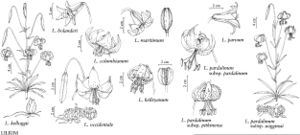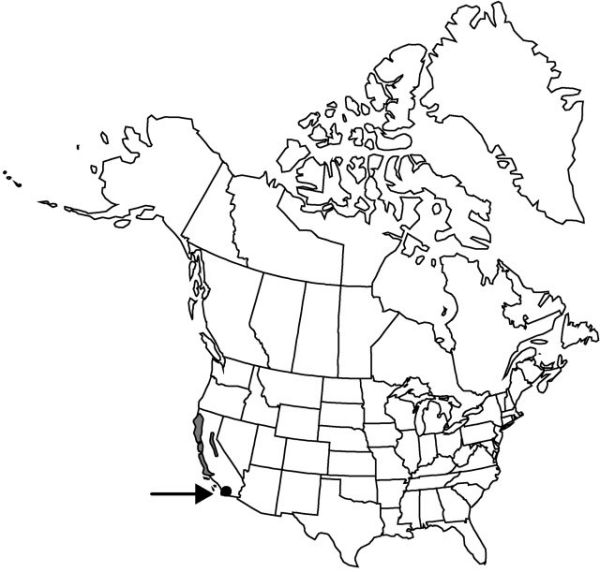Difference between revisions of "Lilium pardalinum subsp. pardalinum"
FNA>Volume Importer |
FNA>Volume Importer |
||
| Line 29: | Line 29: | ||
|elevation=0–1600 m | |elevation=0–1600 m | ||
|distribution=Calif. | |distribution=Calif. | ||
| − | |discussion=<p>Quite variable in flower size, color, and leaf size and shape, <i></i>subsp.<i> pardalinum</i> is the easiest of the western lilies to cultivate. In gardens and in the wild, rhizomes branch regularly to produce clones of stems, and the resulting colonies often become large and the soil matted with bulbs.</p><!-- | + | |discussion=<p>Quite variable in flower size, color, and leaf size and shape, <i></i></i>subsp.<i><i> pardalinum</i> is the easiest of the western lilies to cultivate. In gardens and in the wild, rhizomes branch regularly to produce clones of stems, and the resulting colonies often become large and the soil matted with bulbs.</p><!-- |
| − | --><p>Along the length of the Sierra <i>Nevada</i> this subspecies is replaced at higher elevations by congeners: to the north by <i></i>subsp.<i> shastense</i>, then by <i>L. parvum</i>, and finally by <i>L. kelleyanum</i> in the high Sierra to the south. In the Klamath Mountains it gives way to <i>L. pardalinum </i>subsp.<i> vollmeri</i> in Del Norte County, <i></i>subsp.<i> wigginsii</i> in northern Humboldt County, and <i></i>subsp.<i> shastense</i> in northeastern Trinity County. The range disjunction between the Coast Ranges in Santa Barbara County and the peninsular ranges in San Diego County probably exists because <i>L. parryi</i> replaces <i>L. pardalinum </i>subsp.<i> pardalinum</i> in the intervening mountains. Due to its poor condition, a collection from the Tehachapi Mountains—presumably from Kern County where the plant is otherwise unknown—cannot be confirmed as this taxon.</p> | + | --><p>Along the length of the Sierra <i>Nevada</i> this subspecies is replaced at higher elevations by congeners: to the north by <i></i></i>subsp.<i><i> shastense</i>, then by <i>L. parvum</i>, and finally by <i>L. kelleyanum</i> in the high Sierra to the south. In the Klamath Mountains it gives way to <i>L. pardalinum </i>subsp.<i> vollmeri</i> in Del Norte County, <i></i></i>subsp.<i><i> wigginsii</i> in northern Humboldt County, and <i></i></i>subsp.<i><i> shastense</i> in northeastern Trinity County. The range disjunction between the Coast Ranges in Santa Barbara County and the peninsular ranges in San Diego County probably exists because <i>L. parryi</i> replaces <i>L. pardalinum </i>subsp.<i> pardalinum</i> in the intervening mountains. Due to its poor condition, a collection from the Tehachapi Mountains—presumably from Kern County where the plant is otherwise unknown—cannot be confirmed as this taxon.</p> |
|tables= | |tables= | ||
|references= | |references= | ||
| Line 54: | Line 54: | ||
|publication year= | |publication year= | ||
|special status= | |special status= | ||
| − | |source xml=https://jpend@bitbucket.org/aafc-mbb/fna-data-curation.git/src/ | + | |source xml=https://jpend@bitbucket.org/aafc-mbb/fna-data-curation.git/src/f6b125a955440c0872999024f038d74684f65921/coarse_grained_fna_xml/V26/V26_320.xml |
|genus=Lilium | |genus=Lilium | ||
|species=Lilium pardalinum | |species=Lilium pardalinum | ||
Revision as of 19:31, 24 September 2019
Bulbs branching dichotomously, 2–5.1 × 5.1–19 cm, 0.2–0.5 times taller than long, annual growth evident, generally forming discrete rounded module; scales usually 2-segmented but often unsegmented or 3-segmented, longest 1–2.7 cm. Stems to 2.8 m, strongly clonal, forming dense colonies. Leaves ± evenly distributed along stem, in 1–5 whorls or partial whorls, 3–18 leaves per whorl, usually horizontal and drooping at the tips, sometimes ± ascending, 8.2–24.5 × 0.9–5.6 cm, 3–12 times longer than wide; blade usually elliptic, sometimes ± oblanceolate, rarely lanceolate or obovate, margins usually straight but occasionally ± undulate. Racemes 1–28-flowered. Flowers rarely fragrant; sepals and petals reflexed 1/4 along length from base, yellow, yellow-orange, or orange proximally, usually darker red-orange to red or sometimes pale orange on distal 1/5–1/4; sepals (5.9–)6.6–10.4 × 1–2.1 cm; petals 5.9–10.2 × 1.1–2.5 cm; stamens strongly exserted; filaments often parallel over much of length, then spreading widely, diverging 14°–22° from axis; anthers usually purple, sometimes pale magenta or magenta, rarely yellowish, 1.1–2.2 cm; pollen orange-brown, rust, red-orange, or deep orange; pistil 5.6–7.5 cm; ovary 1.4–2.2 cm; pedicel 8.4–28 cm. Capsules 2.9–5.7 × 1.3–1.9 cm, 2–3.7 times longer than wide. Seeds 147–264. 2n = 24.
Phenology: Flowering summer (Jun–late Aug).
Habitat: Streams and rivers, marshes, seeps, ditches, wet thickets, along coast
Elevation: 0–1600 m
Discussion
Quite variable in flower size, color, and leaf size and shape, subsp. pardalinum is the easiest of the western lilies to cultivate. In gardens and in the wild, rhizomes branch regularly to produce clones of stems, and the resulting colonies often become large and the soil matted with bulbs.
Along the length of the Sierra Nevada this subspecies is replaced at higher elevations by congeners: to the north by subsp. shastense, then by L. parvum, and finally by L. kelleyanum in the high Sierra to the south. In the Klamath Mountains it gives way to L. pardalinum subsp. vollmeri in Del Norte County, subsp. wigginsii in northern Humboldt County, and subsp. shastense in northeastern Trinity County. The range disjunction between the Coast Ranges in Santa Barbara County and the peninsular ranges in San Diego County probably exists because L. parryi replaces L. pardalinum subsp. pardalinum in the intervening mountains. Due to its poor condition, a collection from the Tehachapi Mountains—presumably from Kern County where the plant is otherwise unknown—cannot be confirmed as this taxon.
Selected References
None.

